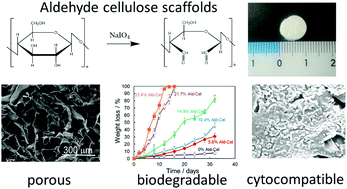Controlling the degradation of cellulose scaffolds with Malaprade oxidation for tissue engineering†
Abstract
This study was conducted to develop biodegradable cellulose scaffolds by oxidising porous cellulose sponges for tissue engineering applications. Cellulose powder was dissolved in ionic liquid using a salt leaching method, and porous cellulose scaffolds of various pore sizes were prepared. The scaffolds were oxidised with periodate to introduce aldehyde at a rate controlled by the periodate concentration. Oxidised scaffolds exhibited weight loss in cell culture medium, but not in phosphate buffer. Therefore, we confirmed that Schiff base formation between the aldehyde and amino groups through a Maillard reaction triggered cellulose molecular degradation. The degradation rate was controlled by the oxidation degree, whereas the aldehyde content controlled protein adsorption and cell proliferation. Additionally, in vivo implantation tests revealed that optimising the oxidation ratio not only improved biodegradability but also reduced inflammation. In conclusion, our results suggest that simple oxidised cellulose is useful as a low-toxicity biodegradable scaffold.



 Please wait while we load your content...
Please wait while we load your content...